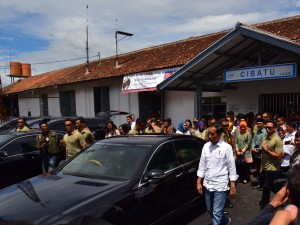President Jokowi Inspects Reactivation Project in West Java

President Jokowi inspects the reactivation project of a number of railways and stations, at Cibatu Stations, Garut, West Java province, Friday (18/1). (Photo: Deny S./PR)
On the sidelines of his working visit in Garut, West Java province, President Joko Jokowi Widodo on Friday (18/1) inspected a number of long-abandoned railways and stations in West Java rail line system that will be reactivated.
For the record, Cibatu-Garut train line has been deactivated since 1983 and the Government plans to reactivate the line. The project is estimated to be finished by the end of this year.
The progress is currently at the land acquisition stage and compensation payment to residents whose buildings are affected (23.93%) and demolition of existing buildings (12.53%).
Other stations and railways to be reactivated are as follows:
1. Bandung-Ciwideuy rail line in Soreang, Ciwidey, Bandung regency. This line was closed in 1975 and used to transport plantation and woods commodities. Today it has the potential of accommodating 5,087 passengers per day.
2. Banjar-Pangandaran-Cijulang rail line in Banjar, Pangandaran. This line, which was closed on 1 February 1982, is expected to accommodate 3,016 passengers per day.
3. Cibatu-Garut-Cikajang rail line. Closed in September 1982, the line was used to transport local commodities, such as vegetables, rice and fruits. Today it has the potential of accommodating 1,113 passengers per day.
4. Rancaekek-Tanjungsari rail line in Bandung and Sumedang. This line, which was built by Dutch railway company Staatsspoorwegen in 1918 and officially opened on 13 February 1921, used to transport tea commodities from West Sumedang during the Japanese occupation (1942-1945). Today it has potential of accommodating 10,250 passengers per day. (EN/DNS/ES)
Translated by: Estu Widyamurti
Edited by: M. Ersan Pamungkas








